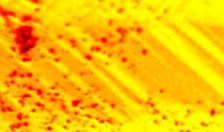Making still smaller and less power consuming digital memories for mobile electronics? Scientists from CNRS and University Paris Sud XI (Laboratory of Solid State Physics, CNRS / Univ. Paris-Sud 11 and Institut Néel) and CEA-IRAMIS come to demonstrate the feasibility, thanks to a new class, said multiferroic, of materials combining unusual electrical and magnetic properties.
This text is a translation of the joint press release from CEA-CNRS-Univ. Paris XI
In a study published in Physical Review Letters, scientists from the Laboratory of Solid State Physics (CNRS / Université Paris-Sud XI), the “Institut Rayonnement-matière Saclay (CEA IRAMIS)” and the “Institut Néel” (CNRS) validate the concept of data writing and storage via an electric field, an advantageous technological way for miniaturization memories.
At the microscopic level, atoms and molecules produce electrical and magnetic fields. At our level, in most crystals, the electrical and magnetic properties of the atoms are balanced and cancel each other. Sometimes this is not the case, and for some compounds, known as ferromagnetic, the magnetic properties remain at the macroscopic scale: they may well serve as a magnet. More rarely, for compounds called ferroelectric, an electric order remains at the macroscopic scale. More rarely, both electric and magnetic exist together: this is the case of multiferroic materials. Moreover, in these materials, electrical and magnetic orders interact. Such interaction provides an opportunity to control the spins (magnetic moments of atoms) via an electric field, which represents a considerable challenge especially for information storage.

Scientists at the “Laboratoire de Physique des Solides (LPS CNRS / Université Paris-Sud 11)”, at the “Institut rayonnement-matière of Saclay (CEA IRAMIS)” and “Institut Néel (CNRS)” have worked on the multiferroic compound BiFeO3, which they have synthesized. They highlight the interplay between the electric and magnetic order. They have further designed a material composed of a layer of BiFeO3 and a ferromagnetic film. They show that by applying an electric field, It is possible to change the preferred orientation of the magnetization of the ferromagnetic film. These pioneer results validate the concept of magnetic data storage and of data writing by application of an electric field.
In the current hard drives, data – or bits – are written with a magnetic field that orients the magnetization. There are two possible states of magnetization and thus two possible values (called 0 or 1) of the bits. With a multiferroic material, each memory element could be placed in four separate states instead of two (two states of electrical polarization and two states of magnetization). One might also consider magnetic memories with their two magnetic states (such as usual memories), but able to be changed by application of an electric field. The ability to write and erase data by means of an electric field offers two advantages for mobile electronics (cell phones, laptops, GPS, etc..): first, the application of an electric field requires less energy than a magnetic field, so the batteries would last longer, and second, the electric field is more localized, thereby allowing to place more memory elements on a given surface (i.e. increasing the component integration).

References:
| Electric field switching of the magnetic anisotropy of a ferromagnetic layer exchange coupled to the multiferroic compound BiFeO3. D. Lebeugle, A. Mougin, M. Viret, D. Colson, L. Ranno, Phys. Rev. Lett. 103 (2009) 257601. |
– Joint press release CEA-CNRS-Univ. Paris XI
|
Viewpoint on the Physical Review paper by Wolfgang Kleeman of APS |
See also on the same topic:
– Electric-Field-Induced Spin Flop in BiFeO3 Single Crystals at Room Temperature,
D. Lebeugle, D. Colson, A. Forget, M. Viret, A. M. Bataille, and A. Gukasov
Phys. Rev. Lett. 100, 227602 (2008)
CEA contact: Dorothée Colson



